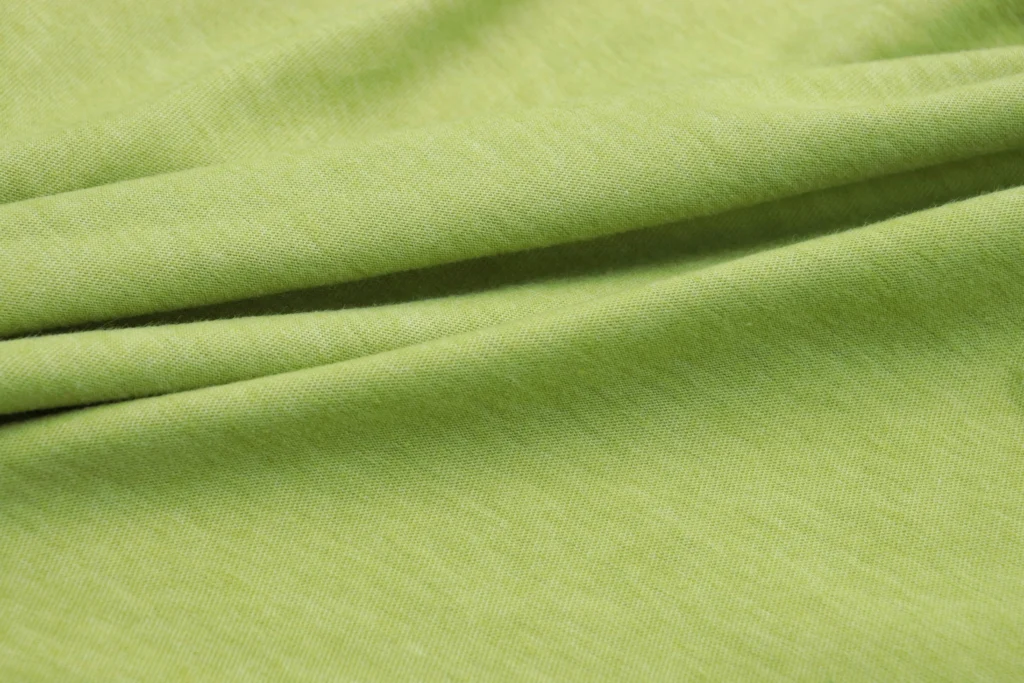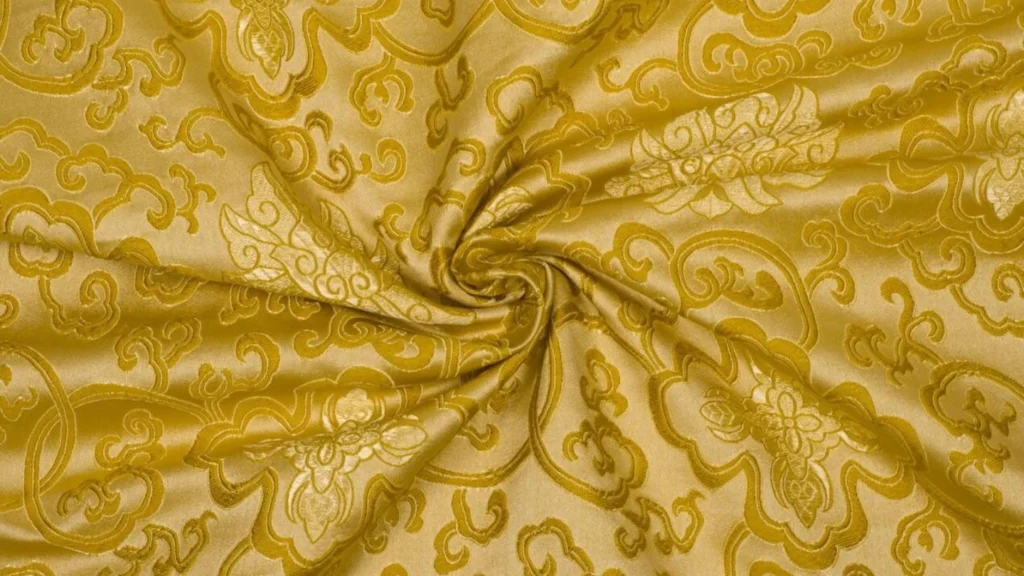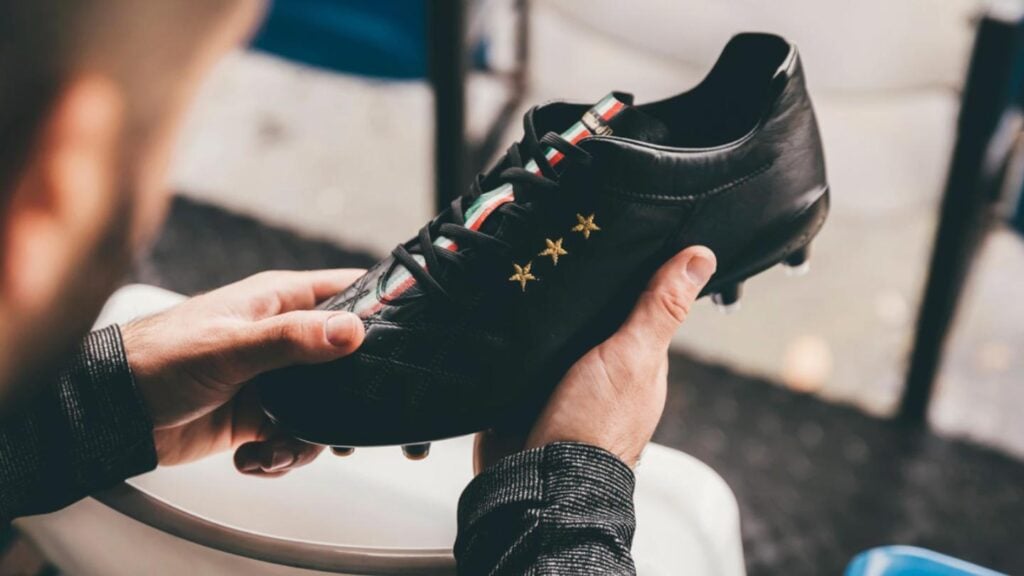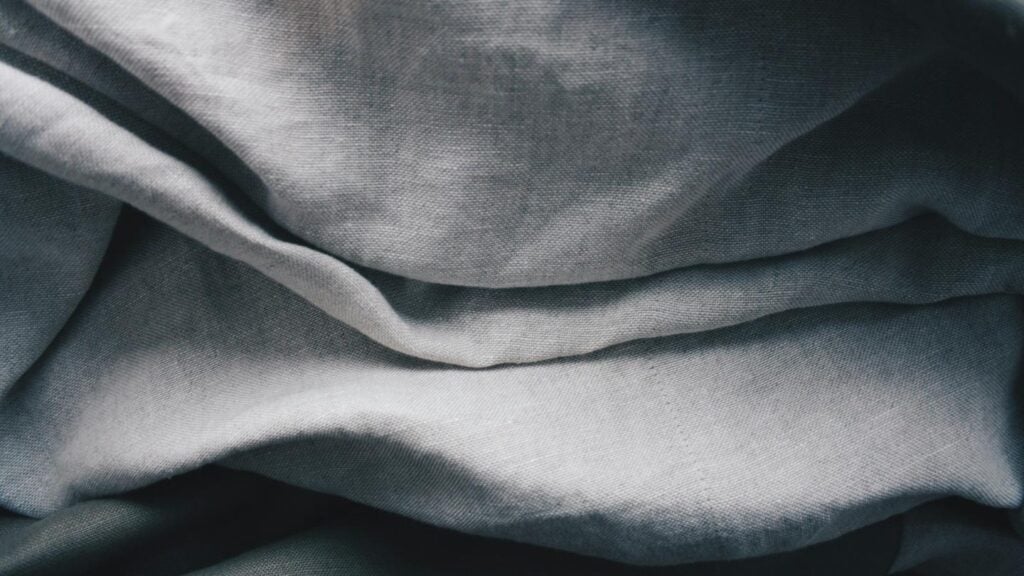2 – Benefits of Choosing Econyl Fabric
3 – Econyl Fabric vs Other Fabrics
4 – How Econyl Fabric Is Manufactured
5 – Common Uses in Fashion
6 – Understanding the Environmental Impact of Econyl Fabric
7 – Exploring Price Points and Value for Money
8 – Conclusion
9 – FAQs
What is Econyl Fabric?
Econyl fabric is a type of sustainable textile made from regenerated nylon, created by recycling waste materials like discarded fishing nets, fabric scraps, and industrial plastics. Unlike traditional nylon, which is produced from petroleum, Econyl uses a closed-loop regeneration process that transforms these waste products into new, high-quality nylon fibers without compromising durability or performance. This innovation not only helps reduce ocean pollution and landfill waste but also saves up to 90% of the energy required to make conventional nylon.

Key Features of Econyl Fabric
- Eco-friendly origin: Made from 100% recycled nylon waste, contributing to environmental conservation.
- High performance: Retains the strength, elasticity, and versatility typical of virgin nylon.
- Wide applications: Used in swimwear, activewear, upholstery, and more.
- Consumer appeal: Favored by eco-conscious brands and customers seeking sustainable alternatives.
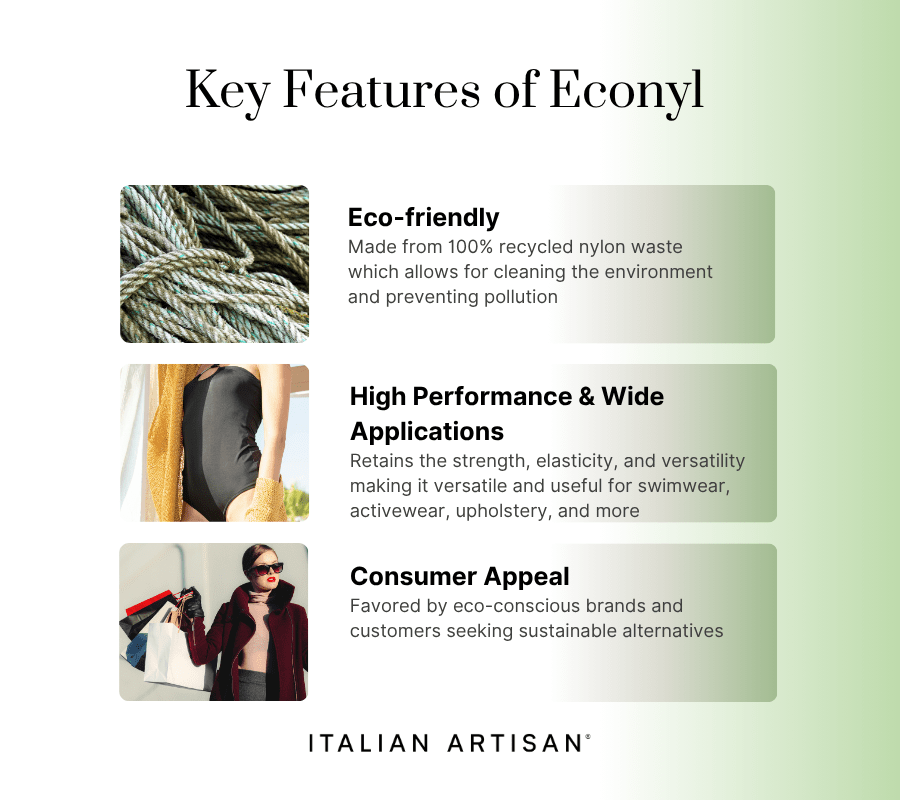
Econyl Fabric Origin:
Econyl fabric was developed by the Italian company Aquafil, a global leader in the production of nylon yarns. The journey began as part of Aquafil’s commitment to creating more sustainable and circular solutions for the fashion and textile industries. Traditional nylon production relies heavily on fossil fuels and has a significant environmental footprint, prompting Aquafil to innovate.
The origin of Econyl fabric lies in its closed-loop regeneration process, which transforms nylon waste — including discarded fishing nets, industrial scraps, fabric offcuts, and even old carpets — into new, high-quality nylon yarn. These waste materials, often destined for landfills or oceans, are collected globally through various partnerships with environmental organizations and fishing communities.
The Regeneration Process Includes Several Key Steps:
- Collection: Gathering nylon waste from oceans, landfills, and production facilities worldwide.
- Cleaning and shredding: The waste is cleaned to remove impurities and then shredded into small pieces.
- Depolymerization: These pieces undergo a chemical process that breaks nylon back down to its raw materials.
- Repurposing: The raw materials are then rebuilt into nylon yarn, identical in quality to virgin nylon.
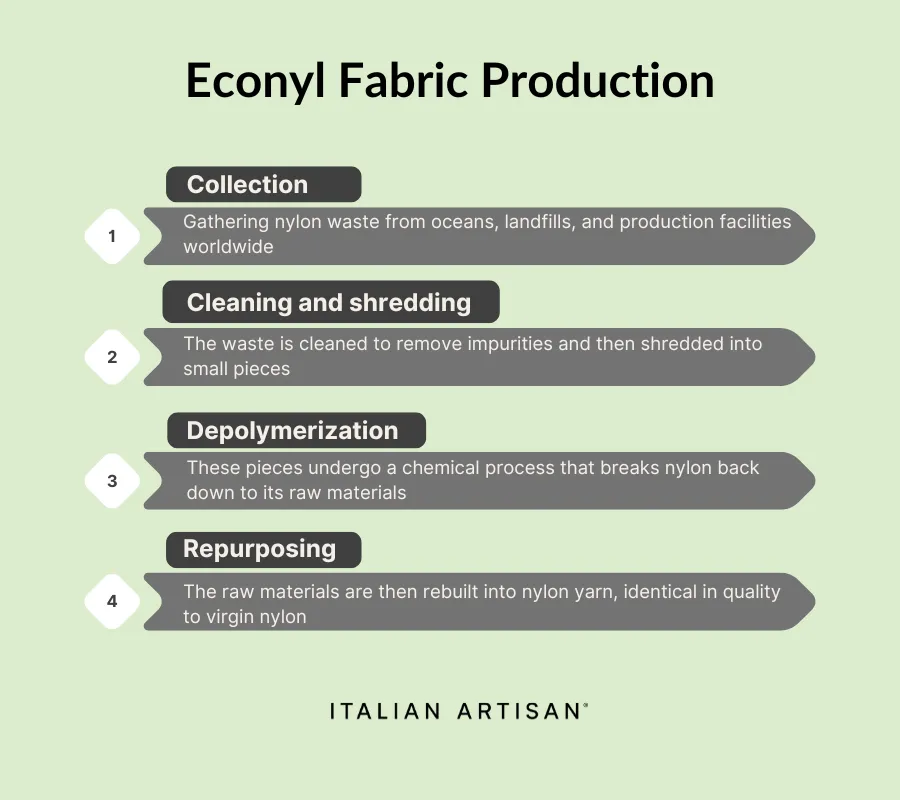
Econyl Fabric Properties
Econyl fabric offers a unique combination of performance and sustainability, making it a popular choice across multiple industries. While it is made entirely from recycled nylon waste, its properties closely match—or even surpass—those of traditional virgin nylon.
Durability:
- Econyl retains the strength and resilience typical of nylon fibers, making it highly resistant to wear and tear extendingthe lifespan of products.
Elasticity and Comfort:
- The fabric maintains excellent stretch and recovery properties, ensuring comfort and flexibility—crucial for activewear and swimwear.
Lightweight and Quick-Drying:
- Lightweight and dries quickly, enhancing its functionality for sportswear and outdoor clothing.
Moisture Resistance:
- Resists water absorption, preventing odors and mold growth, contributing to better hygiene and longer product life.
UV Resistance:
- It offers good resistance to ultraviolet rays, making it suitable for outdoor applications without rapid degradation.
Environmental Benefits:
- Beyond physical performance, Econyl significantly reduces environmental impact by:
- Using 90% less energy compared to virgin nylon production.
- Diverting waste materials such as fishing nets and fabric scraps from oceans and landfills.
- Supporting circular fashion by enabling the fabric to be recycled again at the end of its lifecycle.

Because of these properties, Econyl fabric appeals not only to manufacturers focused on performance but also to eco-conscious consumers who seek high-quality, sustainable products without compromise.
Econyl Fabric vs Other Fabrics
When evaluating Econyl fabric, it’s helpful to compare it to other common textiles to understand its unique benefits and potential limitations. Here’s how Econyl stacks up against virgin nylon, other synthetic fabrics, and natural fibers:
Econyl vs. Virgin Nylon
- Environmental impact: Econyl is made from 100% recycled materials, reducing carbon emissions and energy use by up to 90% compared to virgin nylon, which relies on fossil fuels.
- Performance: Both fabrics offer similar strength, elasticity, and durability, making Econyl a direct sustainable alternative without sacrificing quality.
- Cost: Econyl can be slightly more expensive due to its recycling process, but growing demand and scale are helping reduce prices.
Econyl vs. Polyester and Acrylic
- Sustainability: While polyester and acrylic are also synthetic, most are petroleum-based and less frequently recycled. Econyl’s closed-loop process gives it a clear edge in eco-friendliness.
- Durability: Nylon (including Econyl) tends to be stronger and more abrasion-resistant than polyester and acrylic, which can fade or pill over time.
- Moisture management: Econyl dries faster and resists moisture better than polyester, making it preferable for swimwear and activewear.
Econyl vs. Natural Fibers (Cotton, Wool)
- Resource use: Cotton and wool are renewable but often require significant water, land, and chemical inputs. Econyl’s recycling approach avoids these issues by reusing waste materials.
- Durability and care: Econyl generally lasts longer and requires less special care than natural fibers, which may shrink or wear faster.
- Comfort and breathability: Natural fibers often excel in breathability and softness, whereas Econyl’s synthetic nature can feel less breathable but offers superior stretch and quick-drying properties.
Why Choose Econyl Fabric?
Choosing Econyl fabric means opting for a product that aligns quality, performance, and sustainability. As environmental awareness grows among consumers, Econyl has become a preferred material for brands and buyers who want to make responsible choices without compromising style or functionality. Here are the main reasons to consider Econyl fabric:
Consumer Demand:
More customers seek sustainable options. Brands using Econyl can attract eco-conscious buyers and strengthen their reputation for environmental commitment.
Industry Recognition:
Leading fashion and lifestyle brands have incorporated Econyl into their collections, highlighting its growing acceptance and prestige.
Innovation and Transparency:
With traceable sourcing and a closed-loop production system, Econyl offers transparency that appeals to consumers who want to know the story behind their purchases.

In short, Econyl fabric presents a practical way to enjoy high-performance textiles while actively contributing to environmental preservation. It’s a choice that benefits both the planet and the consumer’s lifestyle.
Care and Maintenance of Econyl Fabric
To ensure the longevity and performance of garments and products made with Econyl fabric, proper care and maintenance are essential. Although Econyl is durable and resilient, following simple guidelines helps maintain its quality, appearance, and environmental benefits over time:
Washing:
- Use cold or lukewarm water (below 30°C or 86°F) to protect the fabric’s elasticity and color.
- Prefer gentle or delicate wash cycles to minimize fiber stress.
- Avoid harsh detergents and bleach, which can degrade the fabric. Use eco-friendly detergents when possible.
Drying:
- Air-dry Econyl products instead of using a tumble dryer, which can damage fibers and reduce elasticity.
- Avoid direct sunlight for prolonged periods to prevent color fading.
Ironing and Care:
- Typically, Econyl fabric does not require ironing due to its synthetic nature and wrinkle resistance.
- If ironing is necessary, use a low-temperature setting with a cloth barrier to avoid direct heat contact.
Storage:
- Store items in a cool, dry place to prevent mildew or odor buildup.
- Avoid hanging heavy swimwear or activewear for long periods as it might stretch the fabric.
End of Life:
- One of Econyl’s advantages is that it can be recycled again through Aquafil’s regeneration process, supporting circularity. Consumers are encouraged to
Proper care not only preserves the look and feel of Econyl fabric but also extends product life, reducing the need for frequent replacement and contributing to sustainable consumption.
The Future of Econyl Fabric as a Sustainable Textile
Econyl fabric represents a significant step forward in sustainable textile innovation, but it is also part of a broader movement toward circular fashion and eco-conscious production. As industries and consumers increasingly prioritize environmental responsibility, the future of Econyl and similar materials looks promising and full of potential:
- Advancements in Recycling Technology: Continuous improvements in chemical recycling processes will make regenerating nylon and other fibers even more efficient, scalable, and cost-effective. This will help expand Econyl’s availability and lower its environmental footprint further.
- Broader Industry Adoption: More fashion brands, designers, and manufacturers are expected to integrate Econyl and other recycled materials into their collections, helping mainstream sustainable fabrics across price ranges and styles.
- Circular Economy Integration: Econyl’s closed-loop regeneration system is a model for circularity in textiles. Future developments may include enhanced take-back programs, consumer incentives, and industry-wide collaboration to recycle old textiles into new materials seamlessly.
- Consumer Awareness and Demand: As sustainability becomes a decisive factor in purchasing decisions, consumers will continue to seek products with transparent, ethical supply chains—strengthening the market for Econyl-based goods.
- Expanded Applications: Beyond fashion, Econyl fabric’s durability and versatility open opportunities in sectors like automotive, furniture, and technical textiles, further increasing its positive environmental impact.
- Regulatory and Policy Support: Governments and organizations worldwide are beginning to incentivize sustainable production and waste reduction, which could accelerate the adoption of fabrics like Econyl.
Produce your fashion collection with us
Common Uses in Fashion
Econyl fabric’s versatility and durability make it ideal for various applications in the fashion industry. Its eco-friendly production process and high-quality performance have made it increasingly popular among designers and brands focused on sustainability. Here are some of the most common uses of Econyl fabric in fashion:
- Swimwear:
One of the most popular uses for Econyl fabric is in swimwear. Thanks to its durability, elasticity, and moisture-wicking properties, it’s perfect for creating swimsuits and bikinis that not only look great but also last longer. Econyl’s ability to resist UV rays also helps swimwear maintain its vibrant color over time.
- Activewear:
Econyl fabric is widely used in activewear, including leggings, sports bras, running shorts, and gym wear. Its stretch and flexibility provide comfort and support during physical activities, while its quick-drying ability ensures sweat management during workouts.
- Athleisure:
The athleisure trend, which combines athletic wear with casual fashion, also benefits from Econyl fabric. Items like leggings, yoga pants, jackets, and tops made from Econyl blend functionality with style, making them suitable for both exercise and everyday wear.
- Outerwear:
Econyl is becoming more common in outerwear items such as jackets and coats. Its durability, resistance to the elements, and ability to retain its shape over time make it an excellent option for high-performance outerwear that also aligns with sustainable fashion practices.
- Fashion Accessories:
Econyl fabric is used in a range of accessories such as bags, hats, scarves, and footwear. Its strength and flexibility make it a great material for creating durable and stylish bags, while its softness can contribute to comfortable, wearable accessories.
- Upholstery and Interior Design:
Besides fashion, Econyl is also used in home décor and furniture upholstery. Its durability, stain resistance, and sustainability make it a practical and stylish option for eco-conscious interior designers.
- Footwear:
Some footwear brands use Econyl for sandals, sneakers, and boots. The fabric’s flexibility and ability to withstand wear and tear make it suitable for shoes that require comfort, breathability, and durability.
- Bags and Backpacks:
Econyl is commonly found in eco-conscious bag collections, including backpacks, totes, and handbags. The fabric’s lightweight yet tough nature makes it ideal for creating bags that hold up to daily use while remaining stylish and functional.
- Lingerie and Underwear:
Due to its smooth texture and flexibility, Econyl is used to create comfortable lingerie and underwear. The fabric’s stretch allows for a flattering fit, and its softness against the skin adds to the comfort.
- Sustainable Fashion Collections:
More and more fashion brands are incorporating Econyl into their collections, focusing on sustainability. Designers use it for both their main collections and limited edition pieces, emphasizing eco-friendly practices while maintaining high-end quality and design.

By incorporating Econyl fabric into various garments and accessories, designers and brands not only contribute to a more sustainable fashion industry but also offer consumers a responsible way to enjoy high-quality products without compromising on performance or style.
Exploring Price Points and Value for Money
Econyl fabric offers significant value for money, combining sustainability with durability and performance. While the initial cost of products made with Econyl might be slightly higher than those made from virgin materials, the long-term benefits make it a wise investment for both brands and consumers. Here’s why Econyl offers great value:
Value for Money
In conclusion, the value of money in using Econyl is evident through its durability, sustainability, and versatility. While the upfront cost may be slightly higher, the long-term savings in maintenance, replacement, and environmental impact make Econyl a smart financial investment for both brands and consumers.
- Durability and Longevity:
Econyl fabric is highly durable, meaning products made from it tend to last longer than their counterparts made from traditional fabrics. Whether it’s swimwear, activewear, or fashion accessories, the strength of Econyl ensures that items retain their appearance and functionality over time. This reduces the need for frequent replacements, which can ultimately save money in the long run.
- Sustainability without Compromise:
While sustainable materials often come at a premium, Econyl offers a cost-effective solution for those seeking eco-friendly alternatives without sacrificing quality. The fabric performs similarly to virgin nylon, with comparable elasticity, strength, and resilience, providing the same benefits at a lower environmental cost.
- Versatility Across Products:
Econyl’s versatility in fashion and accessories—ranging from swimwear and activewear to outerwear and upholstery—means that consumers can use products made from it in a wide variety of contexts. Whether you’re purchasing a high-performance gym outfit or a stylish bag, Econyl’s multi-use properties allow consumers to get more value out of each purchase.
- Reduced Maintenance Costs:
Products made from Econyl fabric are often easier to care for compared to those made from more delicate or natural fibers. Econyl is quick-drying, resistant to water absorption, and durable against wear and tear, reducing the need for frequent dry cleaning or specialized treatments. This translates into lower ongoing costs for consumers.
- Sustainable Investment:
By choosing products made with Econyl, consumers are not only investing in long-lasting, high-quality items but also contributing to a more sustainable future. The fabric is made from 100% recycled materials, reducing waste and minimizing the need for virgin resources. Brands using Econyl are typically transparent about their production practices, allowing consumers to feel good about their purchases from both an environmental and ethical standpoint.
- Brand Reputation and Value:
For brands, using Econyl fabric aligns their offerings with consumer demand for sustainability. As eco-conscious consumers seek more responsible fashion choices, products made with Econyl can help brands attract a loyal customer base willing to pay a premium for sustainable goods. In the long term, this can lead to brand differentiation and higher perceived value in the market.
Conclusion
Econyl fabric transforms nylon waste into durable, eco-friendly material. It combines sustainability with quality, making it a top choice for conscious consumers and brands. .
FAQs
1. What is Econyl fabric?
Econyl fabric is nylon made from recycled waste like fishing nets and fabric scraps, helping reduce pollution.
2. Where does Econyl fabric come from?
It comes from waste materials collected worldwide and is processed by the company Aquafil in Italy.
3. Who uses Econyl fabric?
Many fashion brands and consumers who want sustainable, high-quality fabrics use Econyl.
4. Why is Econyl fabric better than regular nylon?
Because it uses recycled materials and saves up to 90% energy, reducing environmental harm.
5. How are Econyl fabric properties different from other fabrics?
Econyl is strong, stretchy, quick-drying, and eco-friendly compared to many synthetic and natural fabrics.
6. Will Econyl fabric last as long as traditional nylon?
Yes, Econyl has similar durability and performance as virgin nylon.
7. How is Econyl fabric made?
Waste nylon is collected, cleaned, broken down chemically, and rebuilt into new nylon yarn.
8. What fabrics is Econyl fabric compared to?
It is often compared to virgin nylon, polyester, acrylic, and natural fibers like cotton and wool.
9. Why should consumers choose Econyl fabric products?
Because they support recycling, reduce waste, and get durable, high-quality clothing or accessories.
10. Where can I buy products made with Econyl fabric?
Many eco-conscious brands offer swimwear, activewear, and accessories made from Econyl, both online and in stores.



